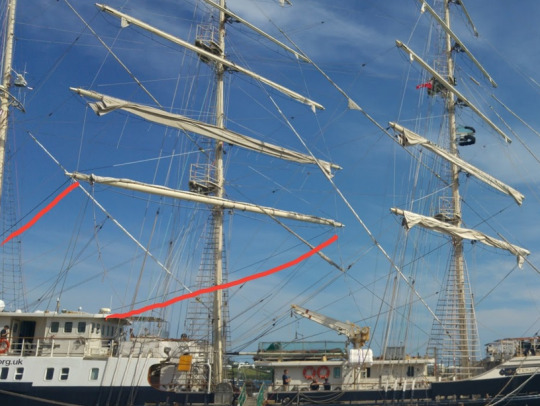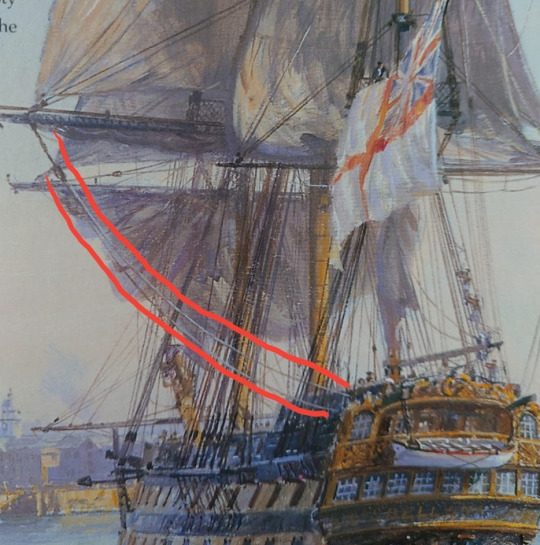Text
Yet More Parts of the Revenge for OFMD Fans
Part 3 of a series: Revenge Master Post.
Sail Names

The Revenge is a square-rigged ship with three masts: the foremast, the mainmast, and the mizzenmast. (The masts are further subdivided into three sections, each with its own name, but this shit is complicated enough already so we’re not going there.) The sails on each mast, from bottom to top, are:
Foremast: foresail, fore topsail, fore topgallant sail
Mainmast: mainsail, main topsail, main topgallant sail
Mizzenmast: spanker (yes, really), mizzen topsail
Before the foremast: fore topmast staysail, jib
The spanker doesn’t follow the naming formula because rather than being square rigged, it’s fore-and-aft rigged, meaning it moves differently and is a different shape.
Sail Anatomy

Each square sail hangs from a horizontal spar (pole) called a yard. (This is what Roach jumps off during Jack’s game of “yardies.”) The ends of the yard are called the yardarms, as in “the sun’s over the yardarm” (time for a drink). The foot of the sail is secured with lines called sheets, as in “three sheets to the wind” (drunk).

Each yard has a specific name based on its location and function. So a sailor wouldn’t just say yard, they’d say main yard or fore topsail yard. This is true of every sail, line, and doohickey on a ship.
Unlike the square sails, the spanker doesn’t hang from a yard but from a gaff (specifically, the spanker gaff). Its foot is secured to another spar called a boom (the spanker boom).
The triangular sails at the bow of the vessel don’t have yards; they’re attached to lines called stays at the top (thus staysail) and to the bowsprit (or its extensions) at the front.
Fun With Sails

So now that we know what they’re called, what kinds of things can the crew do with them? Bearing in mind that the show’s canonical nautical orders are gibberish, here are some suggestions.
Setting
Setting the sails means putting them into position to catch the wind and get the ship moving—that is, get it underway. Sailors climb up (go aloft) to the yards and spread out by standing on the footropes (though these ropes probably weren’t in use in the Revenge’s day). If the sail has been stowed (bundled up and tied to the yard), the crew needs to release the clewlines and buntlines to let the sail unfurl, after which they attach its bottom corners to the yard below by the sheets.

Furling
The sails are usually furled (rolled or folded up) and stowed (tied to the yard) while the ship is moored, that is, tied to a wharf, quay, dock, or pier—in other words, not going anywhere.

Reefing
Like furling, but only partway: to reef a sail is to fold up part of it to reduce the area exposed to the wind. This is done in strong winds to keep the ship stable. To shake out a reef is to release the sail to its full extent again.
Trimming
When sailors trim a sail, they’re adjusting its angle to the wind for maximum efficiency. Yards can also be trimmed, by being moved horizontally around the mast or by tilting the yardarm up or down.
Heaving To
To heave to is to stop the ship where it is, usually by backing some sails to counteract the rest. The past tense is hove to, as in “Upon seeing Blackbeard’s flag, the merchantman hove to and allowed itself to be boarded.”
Rigging

Ropes in storage are ropes; ropes in use are lines. Lines are tied into different knots for different uses—for example, a hitch is the knot used to tie a line to a fixed object, like a bollard (post).
The order to make [something] fast means to lash (tie) it securely. You can also lash something to something, as in “The hostages were lashed to the foremast.” The order to lash up and stow was a British Navy command to tie up the hammocks and stow them out of the way, usually in netting on the inside of the hull.
Each line has a specific name, like main sheet, fore shrouds, or mizzen topsail halyard. The number of different lines is truly staggering, so I’m only going to cover a few of them here. I’ve already mentioned the sails’ clewlines, buntlines, and sheets. To secure one of the lines after adjusting a sail is to belay the line. (Belay also means to disregard, as in “Belay that order!”)
A line that hoists (raises) something, like, say, a flag, is called a halyard. Cables are the thickest, heaviest lines—e.g., what the anchor is attached to—and may need to be moved using the capstan. (Though the anchor is never said to be hoisted; it’s weighed, despite what Frenchie says.)

Here, Jim is sanding in the shrouds. The shrouds are rows of vertical lines on either side of a mast. They serve to stabilize the mast, so they don’t move, which makes them standing rigging, as opposed to running rigging. Between the shrouds run horizontal lines called ratlines. Sailors use the ratlines as rungs to climb aloft.
Beyond the Revenge

When a ship’s not underway, it’s “parked” at an anchorage, which is any place a ship can anchor—usually a port or harbour, but it could be at sea or off an island.
When there’s a wharf, the ship can be moored, which usually means it’s tied to a short post (bollard) on the platform. Unmoored means untied, adrift—literally or metaphorically. Once the ship is moored, the gangplank is placed to allow the crew to walk ashore. If the ship needs major repairs, it is taken to the dockyard.

If the harbour’s too shallow for a ship to dock, its crew will make their way ashore in a smaller boat called a dinghy (or skiff or dory). These boats are kept on board the ship as lifeboats and to ferry supplies and people back and forth.
The dinghy’s rowers sit facing backwards (astern) to row their oars (not paddles), the flat part of which is called the blade. The benches they sit on are called thwarts, because they’re athwart (perpendicular to) the dinghy’s keel. When in use, the oars sit in notches in the gunwales called rowlocks (or oarlocks in Canada and the US).
If, let’s say, Fang decided to row out in a dinghy, he might take a break from rowing for a bit by resting on his oars. When he found a good fishing spot, he’d ship his oars—that is, take them out of the rowlocks and lay them inside the boat.

Zheng Yi Sao’s Red Flag is a type of ship called a junk. The junk is distinguished by its fully battened sails. Battens are strips of wood, usually bamboo, that were inserted into the sails as supports. These sails, whether fan-shaped or rectangular, were easier to handle in many ways, so a junk needed fewer crewpeople than a square-rigged ship like the Revenge.
Miscellaneous Sailing Lingo
Avast: Stede seems to use this to mean “Hey, I’m a pirate!,” but it’s actually an order to stop whatever you’re doing. I imagine Avast, ye! came to be associated with pirates because it’s what you’d say when boarding a ship: “Drop your weapons, everyone!” But that’s just my speculation.

Ahoy: word used to hail another vessel, as in “Boat ahoy!” or “Ahoy the Revenge!”
Fathom: how water depth was measured. A fathom is six feet down, or six feet of line.
League: three nautical miles. A nautical mile was 6,080 feet. (For comparison, a regular mile is 5,280 feet.)
Knot: a measure of speed equalling one nautical mile per hour. According to reddit, a ship that’s 150 feet long would have a top speed of about 16 knots.
Flotsam: debris or cargo left afloat after a shipwreck. Jetsam used to mean parts of a ship or its cargo that had been thrown overboard to lighten the load. The distinction was important for legal reasons to do with salvage rights; today they mean the same thing.

Lee: the side that is sheltered from the wind, whether speaking of a ship, land mass, or rock. Leeward and alee mean on or towards this side, away from the wind.
List: when a ship leans to one side, it’s listing
Capsize: what a boat or ship does when it overturns in water
Founder: to fill with water and sink (not to be confused with flounder, to flail around uselessly)
Pitch, Roll, and Yaw: these describe the motions of a ship. To pitch is to rock between bow and stern. To roll is to rock from side to side (starboard and port). To yaw is for the bow and stern to swivel back and forth.

That’s all, folks! Thanks to everyone who’s contributed to my knowledge by adding notes and comments to my posts. If you see any mistakes, please let me know!

Sources: Wikipedia, historicnavalfiction [dot] com, the OED
89 notes
·
View notes
Text
I’m waiting for something to download, so decided to do an Educational And Informative Post on my absolute favourite line in Our Flag Means Death.
“Hoist the mainbrace!”
Now, I’m sure you’ve heard about splicing the mainbrace. You probably know that, aside from a sneaky tot of rum, splicing involves weaving the ends of two ropes together, either to extend a rope or repair it. But what is the mainbrace? And why does splicing it involve booze? And how does one hoist it?
Well, these are the mainbraces on a modern tall ship (SV Tenacious, owned and operated by the Jubilee Sailing Trust):

And on a Napoleonic era warship (HMS Bellona, 74, as painted by Geoff Hunt):

To position the sails on a tall ship, you move the yards (the horizontal sticks with the big hankies hanging off them). You do this by bracing them – hauling on bits of string to swing them round. Those bits of string are called braces. The braces on the lowest yard, which holds the largest sail, are the mainbraces.
The mainbraces are the longest, heaviest pieces of running rigging on a ship. (Running rigging is the string that gets moved around, as opposed to standing rigging which stays still. Examples of standing rigging are the stays and shrouds which hold the masts up.)
They’re also absolutely essential. Without your mainbraces, you lose a lot of manoeuvrability, you lose a lot of power, and you’re a sitting duck (or seagull) for any passing pirates, Frenchmen or surviving twins out for your blood.
What does this have to do with drinking rum? (My second favourite activity, after pulling on bits of string.) If your mainbrace gets damaged, you have to fix it. Because it runs through blocks and takes a lot of weight, repairing it by splicing is an absolute bastard of a job. It’s usually carried out by the most competent sailors on board (Revenge would struggle) and they were traditionally rewarded with an extra tot of rum. Splicing the mainbrace became slang for rewarding the crew with a drink.
And, finally, how does one go about hoisting the mainbrace?
One doesn’t. One can’t. The order is complete fucking nonsense that makes no sense to anybody who has the slightest clue about how ship string works.
And that’s why it’s my favourite line in Our Flag Means Death.
OFMD said, “We could exhaustively research and get everything correct, à la Patrick O’Brian. We could wing it a bit but aim to be basically correct, à la CS Forester. Or we could go the Knight’s Tale route and say fuck everything.” And then they started blasting Queen’s We Will Rock You and went back to figuring out how to put more leather on Taika Waititi.
And I raise my rum to them for that.
356 notes
·
View notes
Text

more old OFMD art. this was a traditional multi media piece on wood :)
304 notes
·
View notes
Text
This is just an Ed Teach Hair Appreciation Post TM






117 notes
·
View notes
Note
Why is there no push to get Taika an Emmy nomination too? 🥺 He deserves one for the whole of Ed's kraken spiral. Some of the best acting I've seen in years, that.
I was also asking the same question! I was asking about it but didn’t hear back before the recap went out :) Id like to do one for him too personally!!! Gonna see what we can cook up 😉
37 notes
·
View notes
Text

OFMD s2 Moonlight Kiss Horny Stede Bare Shoulder Ed loop save me
save me OFMD s2 Moonlight Kiss Horny Stede Bare Shoulder Ed loop
148 notes
·
View notes
Text
picture of taika in the ed captain uniform with a ponytail save me
save me picture of taika in the ed captain uniform with a ponytail
198 notes
·
View notes
Text

This has got to be the closest to a young Ed Teach of any photo I've ever seen of Taika, and I personally think it's just wow.
440 notes
·
View notes
Text


Brought a treat into the office today. I am smiling far too hard that my first words on seeing the second pic were "Did everyone get cake?“ 😁😁🎂
4 notes
·
View notes
Text
sound on!! bbgirl watching his crush <3
audio pulled from that one bts clip of taika directing s1 ep1
2K notes
·
View notes
Text
sound on!! bbgirl watching his crush <3
audio pulled from that one bts clip of taika directing s1 ep1
2K notes
·
View notes
Text
“In this space right here that we have made for each other, you can say anything and I will not abandon you. Unwrap the worst things you have done. Watch me hold them up to the light and not even flinch.”
— Trista Mateer
3K notes
·
View notes







